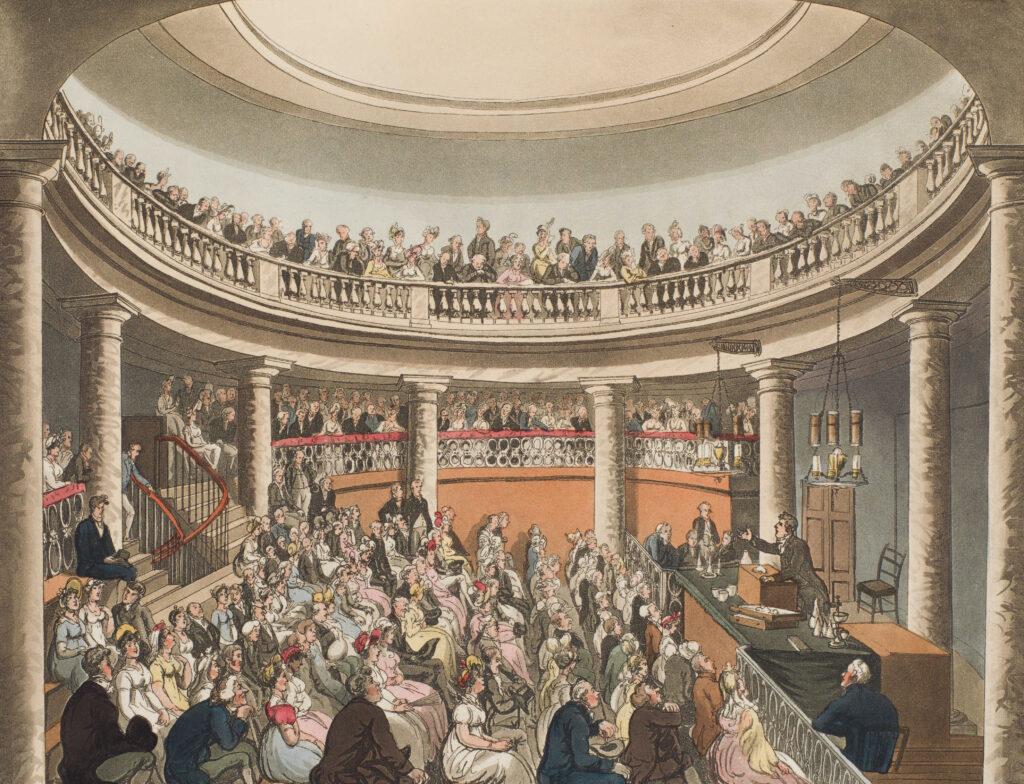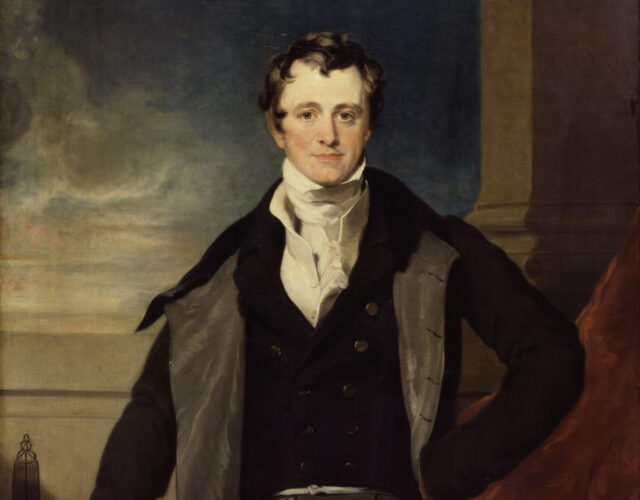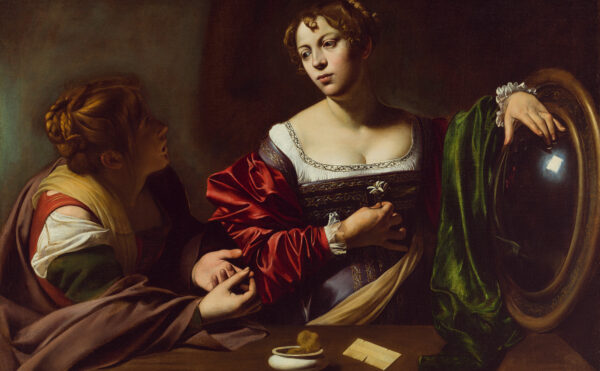Jan Golinski. The Experimental Self: Humphry Davy and the Making of a Man of Science. University of Chicago Press, 2016. 259 pp. $30.
There have been many biographies of Humphry Davy (1778–1829), all of which try to make sense of his unprecedented career: his social mobility in the class-conscious era of Jane Austen; his place in the Romantic movement as poet, philosopher, and sage; his dramatic experimental research and emphasis on the utility and promise of science (especially chemistry); his tangled relationship with his assistant and pupil Michael Faraday; and the dialogues composed as his legacy in his last lonely years.
In a new biography of Davy, Jan Golinski eschews the search for the man behind the masks, instead picking six of Davy’s personae to illuminate his dramatic life and the roles he played in Regency Britain. Golinski uses Davy to cast light on the science and assumptions of that snobbish and brittle (indeed theatrical) society, dominated by prolonged war with Napoleonic France, rapid industrialization, social unrest, and fear of revolution.
Golinski portrays Davy as enthusiast, genius, dandy, discoverer, philosopher, and traveler. Davy would have been happy with four of these labels, but enthusiast in his time carried overtones of poor judgment, and dandy implied a vain and lightweight show-off, like celebrity today. What he could not be was scientist: neither the word nor the thing yet existed in Britain, although the situation was rather different in France.
Paris was the world capital of excellence across all the sciences. Unlike London, it possessed both a center of scientific training and a cadre of professional scientists. Davy’s career and that of his great French rival, chemist Joseph Louis Gay-Lussac, make a tale of two cities.
In Paris, Gay-Lussac won a place at the elite École Polytechnique through a competitive examination. There he caught the eye of chemist and professor Claude-Louis Berthollet. Like a modern PhD supervisor, Berthollet found Gay-Lussac a job, promoted his election to the elite and salaried Académie des Sciences, and sponsored his career.
In London, booming as the Industrial Revolution got under way, fellows of the Royal Society were either landed gentlemen or respectable professionals: medical men, clergy, lawyers, or officers in the navy or army. A few lived hand to mouth, lecturing, tutoring, and perhaps even latching onto a wealthy patron.
The chemist and Unitarian minister Joseph Priestley, for instance, had a very fertile spell as librarian and tutor to the radical reformer and supporter of American independence Lord Shelburne, during which time Priestley isolated oxygen. Priestley later became a minister in Birmingham, where he promoted the secular and democratic ideals of the French revolutionaries until war broke out with France and rioters drove him into exile in the United States. John Dalton, a bachelor Quaker and pioneer of atomic theory, spent his adult life in Manchester, living humbly on a small salary from the Manchester Literary and Philosophical Society. Davy did not want such a life: his eye was on the metropolis and on making his mark there.
In 1798 Thomas Beddoes, a Bristol-based political radical, physician, and chemist, invited Davy to abandon his medical apprenticeship in Cornwall and assist in setting up a clinic to administer Priestley’s new gases, including nitrous oxide, or laughing gas, to patients with lung diseases. Its use became the basis of undignified comic shows, and Davy, as a reckless self-experimenter and seeming quack, was branded an enthusiast. But he also published careful chemical analyses of the oxides of nitrogen, and in a handsome letter the exiled Priestley hailed him as his successor.
Davy’s lucky break came in 1801 when Benjamin Thompson (better known as Count Rumford), a Loyalist exile from New England, invited him to London to lecture at the Royal Institution. Rumford had induced grandees, such as Royal Society president Joseph Banks, to support the institution: its aims were to promote science in the common purposes of life—applying it in agriculture and industry—and to deliver popular lectures to upper-class men and women. Davy proved brilliant in his talks and demonstrations, and with his earnest rhetoric, glittering eye, demonstration-experiments, and command of his subject he offered his audience an almost theatrical experience. He was lionized, sought after for dinner parties, taken up by the aristocracy and gentry, and generally considered a young genius.
This charismatic upstart duly provoked envy and snobbery; he was portrayed as a spoiled child and a humbug, a dandy, an entertainer holding forth to women and chatterboxes. Golinski suggests that Davy’s concern for women to participate in science and his seductive rhetoric seemed unmanly in a wartime world where separate spheres for the sexes were emerging. In fact Davy was a fearless experimenter, risking death by breathing unknown gases, suffering electric shocks, and getting injured in explosions; as he later wrote, his laboratory life was “a service of danger” for the good of humanity, a service comparable to that of British soldiers fighting Napoleon.

Humphry Davy lectures at the Surrey Institution in this engraving from Rudolph Ackermann’s Microcosm of London (1808–1810). Davy’s charismatic demonstrations helped pave his way into Britain’s high society.
As Davy extended the Royal Institution’s mission to include fundamental research, he boosted the seriousness of his reputation. In 1807 he isolated and named potassium and sodium in a spectacular experiment, using a giant battery to decompose their oxides into their metallic elemental forms. Whereas gravity was universal, chemical reactions were puzzling, dependent like human relationships on what were called “elective affinities,” the preference of a chemical substance to combine with one specific substance over another. Davy’s success in isolating these elements followed from his perception that the chemical bond is electrical. That brought him, despite the war, a prize from the Académie des Sciences in Paris. Davy’s further experiments established chlorine as an element. He even proved Antoine-Laurent Lavoisier, the premier chemist of the day, wrong in his theory that oxygen was present in all acids; Davy demonstrated that hydrochloric acid contains no oxygen, suggesting instead that electrical charges must be responsible for acidity. He made use of Shakespeare in his triumph over the French, dismissing Lavoisier’s theory as “the baseless fabric of a vision.” Davy was now Britain’s leading chemist, one of the great discoverers, set against Lavoisier as a systematizer of chemistry.
By 1813 Davy was knighted, married to a wealthy widow with an interest in science, and ready to set off for France with his wife, bringing Faraday along as assistant and factotum. There he engaged in a race with Gay-Lussac, his great rival, to analyze the substance in seaweed that sublimed to give a violet vapor. Davy recognized it as an analog of chlorine and named it iodine.
Back at home Davy’s correspondence reveals him as increasingly grumpy, fighting furiously for priority when he could have been magnanimous, and feeling insecure about his status in society. The miners’ lamp, a pioneering piece of applied science that made Britain’s coal mines safer, brought him a baronetcy but also mired him in an unnecessary priority controversy. As a self-made man, Davy had little sympathy for those less fortunate than him or for the institutions that aimed to educate the working classes.
Other failings included his refusal to recognize Faraday’s scientific maturity and so spoiling their relationship. Davy’s seven-year presidency of the Royal Society did not go well. Since Banks had been elected the society president a few days before Davy was born, following him was bound to be difficult. By 1820, the year of Davy’s election, reform was in the air, and Davy’s world of aristocratic patronage seemed old-fashioned to impatient young fellows of the society impressed by France’s new world of professional science, specialization, training, and expertise. His presidency ended in 1827 when he suffered a stroke after presiding at the society’s annual celebration.
Only when fishing and shooting or traveling abroad in the Alps could Davy be relaxed and philosophical. As a “philosophical traveler” he noted the geography, geology, animals, and plants of the districts wherever he went, starting this practice as a young man in Great Britain and Ireland and later on the Continent. In Italy he sought a way to soften and unroll papyri found in Herculaneum and befriended the sculptor Antonio Canova, who got Davy permission to analyze the pigments used in the wall paintings of Pompeii.
Davy sought recognition as a philosopher, one who like Newton thought deeply about the nature of matter, life, and science. In retirement in 1827 he began writing Consolations in Travel; or, the Last Days of a Philosopher (published in 1830). The great themes of the book are the order and beauty of the world, the emptiness of materialism, the immense and insufficiently appreciated value of chemistry in improving lives, and, unsurprisingly for a person facing a terminal illness, the immortality of the soul. Davy’s colleagues can sometimes be recognized among the personae in the dialogues, while other dialogues represent Davy talking to himself.
In 1829 he had a stroke while in Rome, where he was trying to get an electric fish to decompose water, as had been done with Volta’s battery. Davy died in Geneva a few months later, while making his way home. He would have been gratified that his obituary writer, the great anatomist and early paleontologist Georges Cuvier, recognized Consolations as the work of a dying Plato.
Davy’s towering (if mixed) contemporary reputation survived into the Victorian era. But his unique career, from provincial apprentice to the world of great lords, seemed weird to the new generation living by science, the first to be called scientists. Davy regretted that almost all of his audience were mere spectators rather than serious recruits to science, and his attempt to write a textbook was not a success; it was idiosyncratic, mostly concerned with his own work, and reflected his lack of formal training.
Davy’s main legacy may well be Michael Faraday, who, through his informal apprenticeship, became Davy’s disciple, sadly estranged but carrying forward Davy’s electrochemical program. Unlike Davy, Faraday was recognized throughout his life as a professional chemist. He was a member of the Sandemanians, a religious sect indifferent to the empty temptations of the world; he eschewed prominent positions, declining the honors and presidencies that Davy had seized on as opportunities and responsibilities.
Davy’s life marked a time of rapid change; along with specialization and the rise of science as a profession came revolutions, war, industrialization, and political reform. Golinski’s accessible book, using some new sources as well as familiar ones, is a fresh way of looking at the amazing career and elusive character of a great and perhaps underrated chemist, who began the task of understanding chemical affinity by way of electricity.




